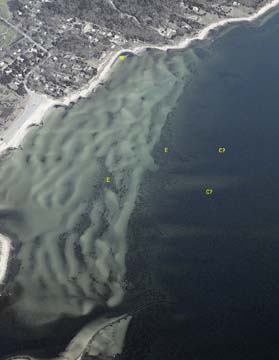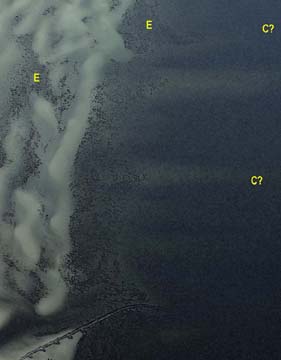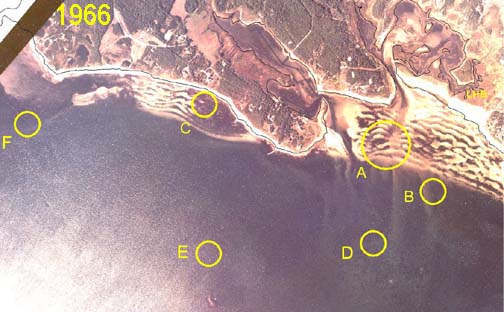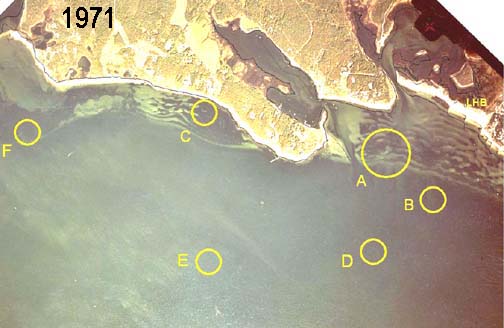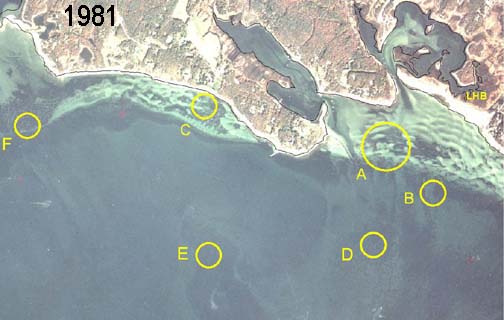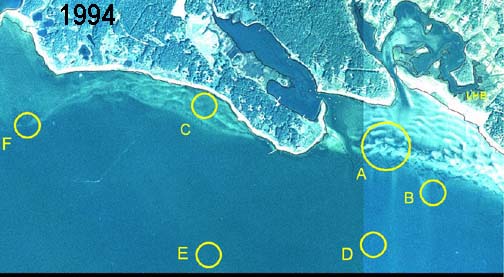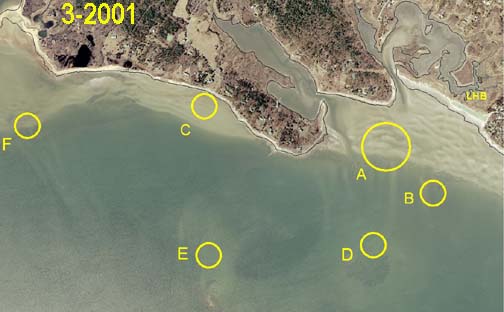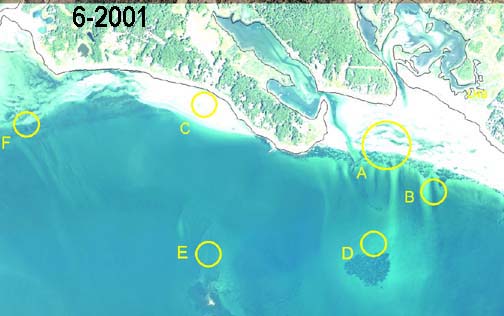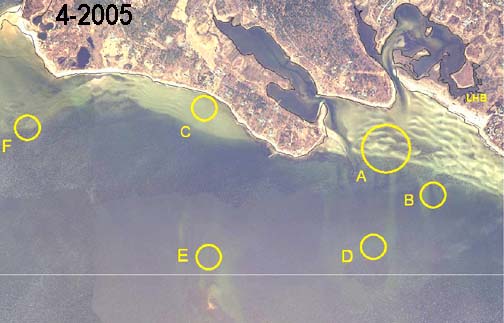Codium seaweed population explosion off Little Harbor Beach, Wareham, MA: Is it related to the collapse of eelgrass populations in northern Buzzards Bay?
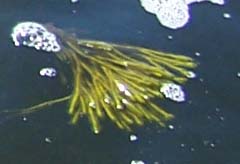
by Dr. Joe Costa
In December 2005, a large amount of Green Fleece seaweed had washed ashore at Little Harbor Beach in Wareham. The algae, also called Dead Man’s Fingers, goes by the scientific name Codium fragile, subspecies tomentosoides. While large accumulations of seaweed and eelgrass wrack can be found in some areas of Buzzards Bay in the winter, the fact that wrack consisted almost exclusively of Codium was striking.
Codium has been abundant offshore of this area for at least 20 years. In the 1980s, while diving offshore this area to map eelgrass (Zostera) beds, I observed much Codium interspersed within the eelgrass beds. However, the volume of Codium that recently washed ashore is symptomatic of broader ongoing changes in the coastal ecosystem in Wareham’s coastal waters.
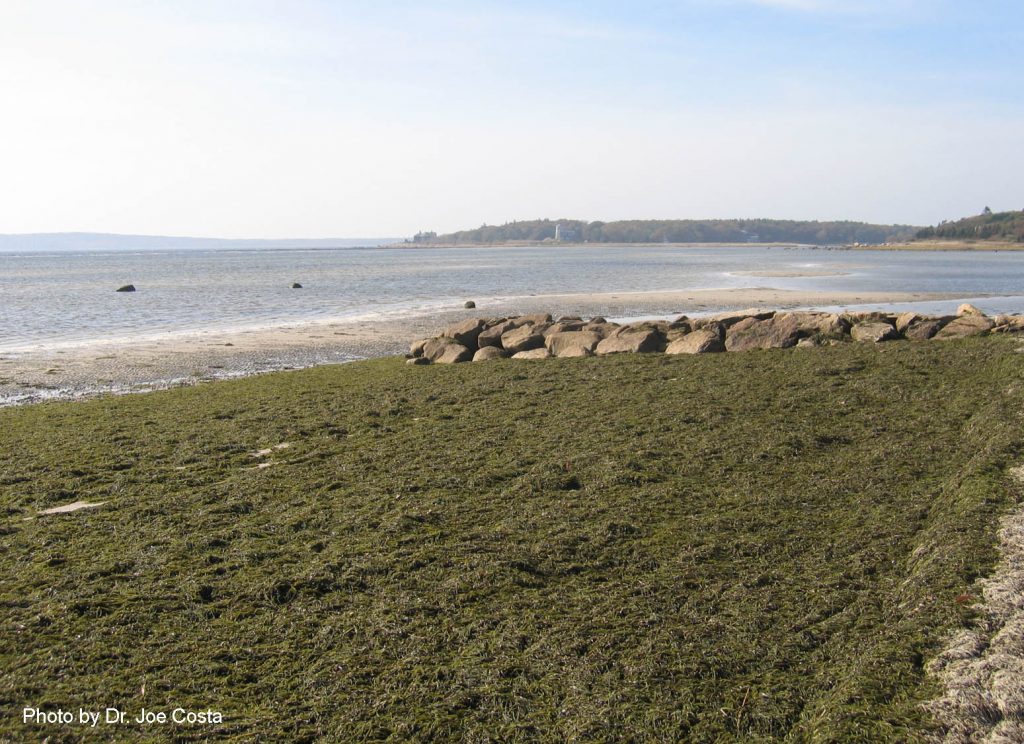
According to Wareham DPW Director Mark Gifford, the Codium problem has persisted through the spring and summer of 2006. He reported that this spring was the first time Wareham officials observed such a massive accumulation of Codium wrack, and the accumulations have been a nuisance to both beachgoers and the DPW, which has had to haul away truckload after truckload of the odious decomposing Codium wrack. One resident complained that after a 10-day hiatus of the DPW cleaning the beach in July, the Codium wrack had reaccumulated to 2 feet in thickness and beachgoers were creating mounds and paths through the stranded Codium to access the water.
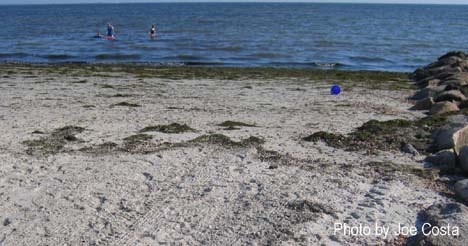
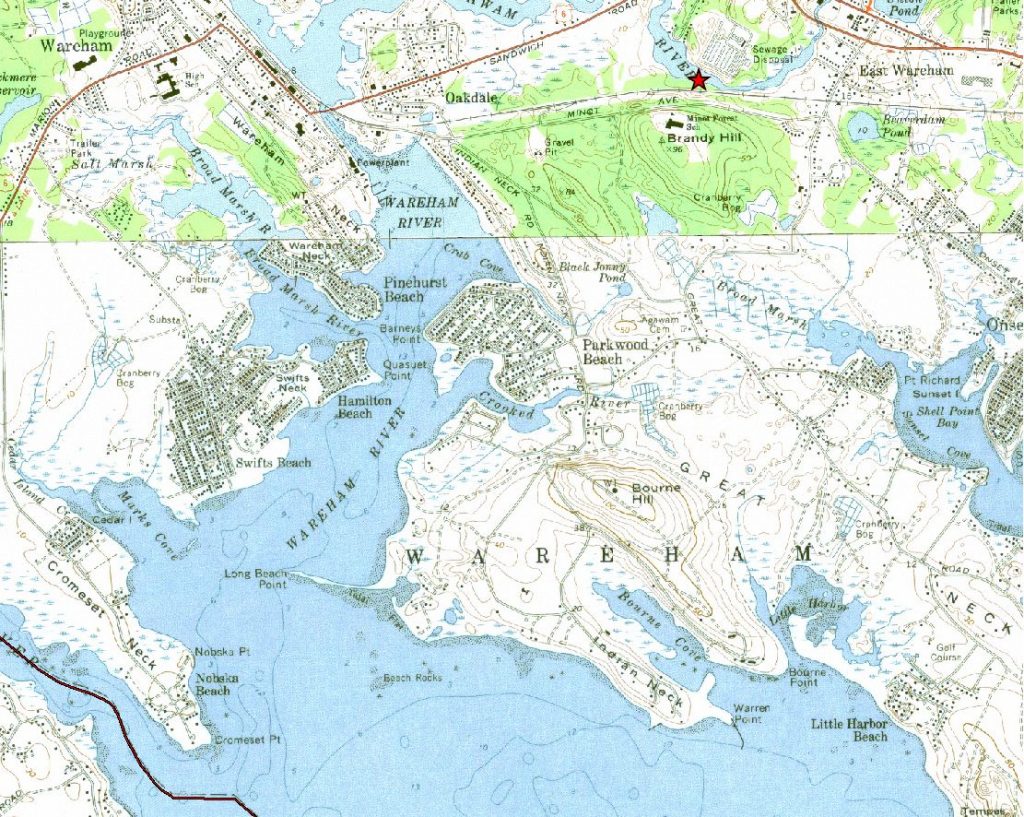
The widespread Codium problem
Codium is a robust alga with a sponge-like texture, often growing in two-foot across bush-like shapes. While this alga can crowd out and shade other plants and algae, one of the most serious problems with Codium is that it is a killer of shellfish. It does this by the simple act of growing on shells, and causing them to be smothered (in the case of oysters it is nicknamed the oyster thief), or causing the shellfish to be pulled up from the bottom and washed ashore. In Buzzards Bay, this is a common occurrence for whelks, slipper shells (Crepidula), and bay scallops. The accumulation of dead shellfish in Codium wrack is one of the main reasons why this beach wrack smells stronger, and attracts more flies, than the native eelgrass beach wrack.
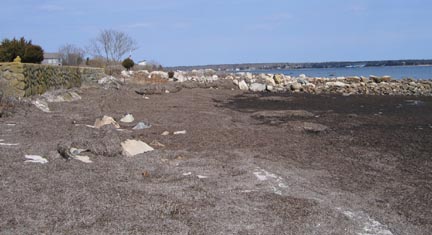
In May, Dr. Don Cheney of Northeastern University, and his graduate student Chris McHan, contacted us about their study of competition for space between eelgrass and Codium. These photographs of Little Harbor Beach have prompted many questions, and this area may be included in their research.
The demise of eelgrass in northern Buzzards Bay
For millennia, eelgrass was an important subtidal perennial plant in Buzzards Bay, and eelgrass beds were an important habitat and nursery for fish, crustaceans, shellfish and birds. Eelgrass is a flowering plant that produces underwater pollen and seeds and is similar to land grasses in its growth and reproduction.
In the early 1930s, a mysterious Wasting Disease thought to be caused by a cellular slime mold wiped out nearly all eelgrass throughout the North Atlantic. The spread of the disease may also have been triggered by environmental causes, such as a period of exceptionally warm and dry summers. Only a few refuge populations of eelgrass survived this disease, and these beds provided seed stock for the recolonization and recovery of eelgrass during the subsequent 35 years. In most of Buzzards Bay, eelgrass was not abundant again until the mid 1960s and 1970s. One area included in the 1988 eelgrass study was the recolonization of the shallows off Great Neck and Little Harbor Beach in Wareham. This area had likely been covered by eelgrass before 1930, and by the 1960s, eelgrass was once again dominant offshore in some of the most expansive beds in Buzzards Bay. In the 1980s the Town of Wareham bought a vehicle to clean beach wrack off Little Harbor Beach because of the extensive accumulation of eelgrass that collected there. This south facing beach sits in a funnel of land facing the southwest prevailing summer winds of Buzzards Bay. The beach was always a natural accumulator of beach wrack and the accumulation of eelgrass wrack prompted the Municipal Maintenance Department to purchase the equipment to collect and remove eelgrass wrack during the bathing season.
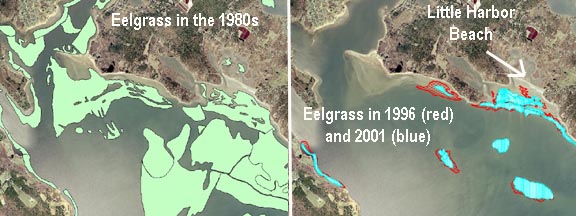 Eelgrass loss in Wareham between the Weweantic River and Great Neck in Onset. |
However, within a decade (during the 1990s), the town hardly needed to clean eelgrass wrack off the beach. At the time, the change seemed a mystery, but looking back, the reason for this change is now evident–nearly all the eelgrass in the offshore waters of Wareham in Buzzards Bay had again died off during the 1990s.
Causes of Eelgrass Loss and Coastal Eutrophication
The first inkling of a problem with offshore eelgrass beds in upper Buzzards Bay came to the Buzzards Bay NEP from shellfisherman in Bourne where eelgrass had mysteriously disappeared in areas that had a great expansion less than a decade earlier. The loss of eelgrass in coastal embayments had been documented due to excessive nitrogen loading. The mechanism for this was that inorganic nitrogen promoted the excessive growth of algae in the water, on the bottom, and on surfaces, essentially shading out eelgrass. But while this pattern occurred in harbors and bays, it was not observed in the more open well-flushed waters of Buzzards Bay. Losses in offshore shallow areas were thought more likely to be associated with storm damage or sometimes heavy winter icing.
New Bedford was the exception to the rule that coastal eutrophication only occurred in poorly flushed embayments. Poor water quality around the City prevented any growth of eelgrass until the early 1990s. The lack of eelgrass there seemed to be the result of poor water transparency caused by the discharge of sewage with only a primary level of treatment, and the discharge of raw sewage from failing combined sewer overflows that fringed the shore, even during dry weather conditions. These conditions, together with the absence of nearby eelgrass seed stock, precluded the growth of eelgrass around New Bedford for decades, even along the well-flushed coastlines facing Buzzards Bay.
In the mid 1990s, Charles Costello of the MA Department of Environmental Protection initiated an eelgrass-mapping program to document eelgrass trends in eelgrass in Massachusetts as a follow-up to earlier mapping studies. The 1996 aerial photography and follow-up field survey showed the near collapse of eelgrass in Wareham waters. However, there were certain problems with the study. The aerial photograph was taken at the start of June, and the water transparency in the photographs was often less than ideal. The fact that the photography was taken early in the growing season meant that eelgrass was not as dense and dark on the aerial photographs and that certain shallow beds, which grow from seed each year, might not have fully developed. Deeper areas, like the beds off Great Neck could be missed if water transparency on the photographs is poor. These sites were not included in the field verification survey. Was the lack of eelgrass off Great Neck real, or a limitation of the survey? DEP’s field checking by boat in some areas suggested some of the declines were real, but it was not clear if the disappearance was caused by pollution or some natural phenomenon like storm erosion.
At about the same time, Dr. Fred Short of the University of New Hampshire, who had studied the eelgrass wasting disease for years, had plausible evidence that localized outbreaks of the wasting disease frequently occurred in nature. This could account for some of the reported losses that we observed in Bourne and Wareham. However, if eelgrass had disappeared because of disease, or if the loss was the result of storms or icing, it should recover naturally in a few years. If it did not, then the culprit is most likely pollution and poor water clarity.
The scope of the pollution problem in Wareham’s waters became evident when the Buzzards Bay NEP began nitrogen-loading assessments (see August 1998 report September 1998 report) for the Wareham River estuary (Wankinco-Agawam River complex) to evaluate potential impacts of the town’s wastewater treatment facility and to recommend a treatment level for the upgraded facility. We then began to appreciate the magnitude of the nitrogen-loading problem in the waters of Wareham. Expansion of sewering in Wareham during the 1980s and 1990s was leading to ever increasing amounts of nitrogen discharges in the estuary. Exacerbating the problem was a dramatic increase in new development throughout the 1980s and 1990s with new nitrogen inputs from lawns and septic systems. And finally cranberry bogs, accounting for nearly a quarter of the watershed nitrogen inputs to coastal waters, were increasing in acreage in the watershed.
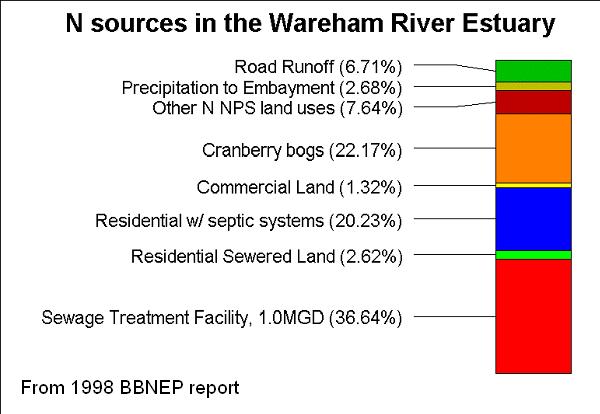 Nitrogen sources reaching coastal waters in the Wareham River Estuary based on the BBNEP’s August 1998 report September 1998 report. |
But the Wareham River estuary was not the only source of pollution to the waters off Great Neck. The Weweantic River, which drains the largest subwatershed in Buzzards Bay, and includes most of the cranberry bog acreage in watershed, also has poor water quality, and this river affects conditions in Wareham’s waters off Great Neck. By the late 1990s, it was beginning to be clear that the loss of eelgrass was a real and persistent problem caused by coastal eutrophication in upper Buzzards Bay from several major sources.
In 1998, based in part on Buzzards Bay NEP nitrogen loading findings and recommendations, EPA required tertiary treatment to remove nitrogen at the Wareham wastewater facility. While everyone recognized that treating this discharge alone would not fully restore water quality, the upgrade of the facility was expected to result in measurable improvements in water quality in the Wareham River. The Town of Wareham completed the facility upgrade in late 2005 and it came on line in the spring of 2006. The EPA permit requires that the facility discharge no more than 4 ppm total nitrogen during marine alga’s fastest growing season of March to October (down from an estimated 15 to 20 ppm total nitrogen). This limit was based on “best available technology” for a practical solution to the town’s wastewater treatment needs.
In February 2006, DEP released its new eelgrass maps for Buzzards Bay based on mid June 2001 aerial photographs and additional field surveys. This new survey confirms the persistent loss of eelgrass in this offshore area. We have been using the new survey information and other archived aerial photographs to piece together a more complete interpretations of the changes in eelgrass and algal abundance offshore.
Causes for the Proliferation of Codium
The reasons for the expansion of Codium is a little more complicated. Codium needs a hard substrate to grow on. The sand bars and flats offshore of Wareham have few rocks, but they do have many small pebbles and gravels, and attached to those pebbles and rocks are slipper shells (Crepidula snails). Other shellfish like whelks and bay scallops were also common here. All these shellfish are prime real estate for the settlement and growth of Codium. Elsewhere in Buzzards Bay, Codium growing on smaller shells and rocks gets carried away by currents and waves, but in upper Buzzards Bay, conditions seem just right to prevent Codium from being washed away, until it grows too large.
In the 1980s, while diving in the waters off Great Neck, I was struck by the fact that eelgrass and Codium coexisted with nearly equal cover in some areas. Codium needs less light, so it could grow deeper than eelgrass and was one of a few large algae growing on the bottom.
Codium is generally not thought of as an opportunistic species that reacts quickly to high nitrogen inputs, like some other green algae such as sea lettuce and tube weed (Ulva and Enteromorpha). However, scientists recognize that Codium, like most algae, will increase growth in response to persistent elevated nitrogen levels in the water. In Buzzards Bay, it also is more common in eutrophic harbors and around piers. In better flushed rocky habitat it is found mixed in with other algae, but generally in no great abundance.
Thus the same increase of nitrogen that caused the loss of eelgrass from Wareham waters may be causing the proliferation of Codium offshore. Conditions off Great Neck may also offer a competitive advantage of Codium over eelgrass. Last summer, because of heavy summer rains, The Buzzards Bay Coalition recorded some of the worst water quality in their program’s 14-year history. It is possible the heavy rains increase nutrient levels in the waters of Great Neck that then boosted Codium production, and accounts for the massive amounts of the algae washing ashore there. Heavy spring and summer rains in 2006 may further exacerbate the problem.
A Silver Lining
There is one silver lining in this story. The town of Wareham’s upgraded facility is now in operation, and will decrease nitrogen loading to the Wareham River estuary by perhaps a third. Our estimates were based on a nitrogen-loading model a decade ago, but did include the planned expanded sewering of Wareham. The DEP Massachusetts Estuaries Project is now studying the estuary with a more refined nitrogen loading and ecosystem response model, and we will have a better understanding of the expected environmental benefits of the sewage treatment plant upgrade in 2007. The upgrade, together with the ongoing expansion of sewering in nearshore villages like Rose Point and Swifts Beach, could result in appreciable improvements in water quality in the next few years. Although some of these areas are outside the Wareham River estuary subwatershed, these villages do affect loading in the waters off great neck.
When the City of New Bedford upgraded its wastewater facility in the 1990s, and fixed failing CSOs, within 5 years there was a great expansion of eelgrass in the outer harbor and in Clarks Cove. Elsewhere in the US, upgrades to wastewater facilities have often been associated with recovery of seagrasses. The summer of 2007, if it has an average rainfall, could show a marked improvement in Wareham River water quality and eelgrass populations.
While we believe this reduction in nitrogen in the Wareham River estuary will result in the recovery of eelgrass, the outcome is still uncertain. The waters off of Great Neck are troubled by many nitrogen sources. Wareham is also struggling with rapid growth and has no nitrogen control regulations in place, like a nitrogen overlay district. As we have continued to note in our reports to town officials (see also our October 2003 Wareham Nitrogen Brochure December 2000 letter to EPA on treatment plant upgrade 2003 proposed nitrogen limit for new Wareham Subdivisions) the failure of the town to manage nitrogen inputs from new growth will eventually overtake reductions in nitrogen achieved by the sewage treatment facility upgrade. Recently we sent draft nitrogen overlay district regulations to the planning board, and on August 14 I will meet with them to discuss their potential implementation in Wareham.
Another way the town can take action is to promote better control of nitrogen release from cranberry bogs. The Buzzards Bay NEP has estimated that perhaps as high as 10% of the bog area in the Wankinco and Weweantic basins are so-called flow-through bogs. That is, these bogs have streams or rivers that flow through them, and these rivers or streams are not separated from the bogs by berms or dikes. On these kinds of bogs, it is much more challenging for farmers to keep fertilizer and pesticides out of the stream or river, especially after heavy rains.
Supporting Photographs
Below are a series aerial photographs, including some never before published, with explanations that illustrate points made above.
References Cited without Links
Carlton JT and Scanlon JA (1985) Progression and dispersal of an introduced alga: Codium fragile ssp. tomentosoides (Chlorophyta) on the Atlantic coast of North America. Botanica Marina 28: 155-165
